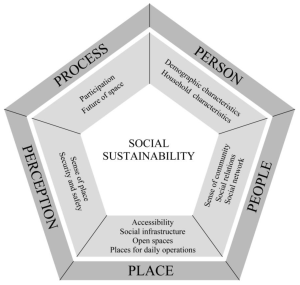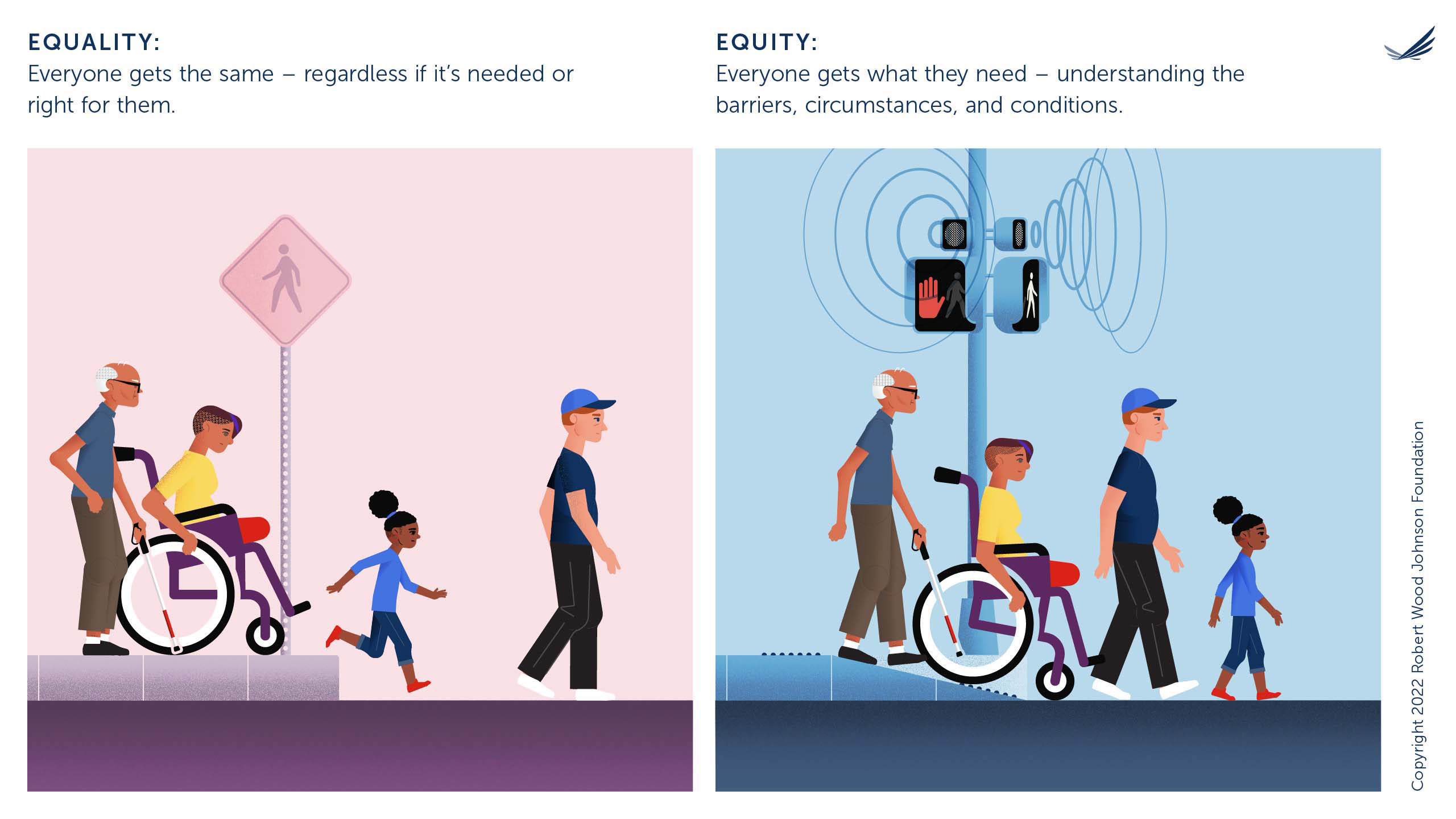Chapter 1: Social Challenges
Defining Social Sustainability
Social sustainability refers to the capacity of a society to maintain and improve the well-being of its individuals and communities over time. It encompasses principles like equity, social justice, cultural diversity, and community cohesion. A socially sustainable society ensures that all members have access to essential resources, opportunities for participation, and a sense of belonging, while also fostering environments that support social interactions, cultural expression, and human rights. The goal is to create systems that promote long-term social health and resilience, balancing the needs of present and future generations.
Social sustainability at three levels
We can examine social sustainability at three levels: global, community, and business.
At the global level, we can refer to the Sustainable Development Goals (SDGs), which aim to reduce poverty, inequality, and hunger, while improving health and promoting peace worldwide.
At the community level, we can refer to the Pentagon model of social sustainability. This model emphasizes the need for diversity, safety and security, robust infrastructure, a sense of community and belonging, and resilience. The Pentagon Model of Social Sustainability proposed by Akcali and Cahantimur (2022). The model includes five interconnected dimensions of social sustainability, as shown below.

1. Place: The “Place” dimension focuses on the physical infrastructure that supports social well-being. It includes access to public spaces like parks and community centers, healthcare and educational facilities, affordable housing, and transportation systems. A clean and healthy environment also plays a vital role, as sustainable design contributes to a higher quality of life and supports community resilience.
2. People: This dimension emphasizes social cohesion and the quality of relationships within a community. It includes strong social bonds, shared values, inclusivity, and cultural identity. Open communication, support systems, and embracing diversity help create communities where individuals feel connected, valued, and supported in their personal and collective lives.
3. Population: The “Population” dimension deals with the demographic characteristics of a community. Factors such as age, gender, ethnicity, education, and household structures are key to understanding social needs. Health, well-being, and access to education and skills training are essential for individual development and the community’s long-term sustainability.
4. Process: This dimension captures a society’s ability to adapt to change. Adaptive governance, technological innovation, and economic resilience are critical for long-term flexibility. Communities that engage residents in decision-making and support evolving lifestyles can respond better to emerging challenges and maintain social stability.
5. Perception: “Perception” addresses how people feel about their safety, justice, and stability. A strong sense of security, trust in legal systems, and belief in economic opportunity all influence how individuals experience their environment. Positive perceptions can enhance belonging and contribute to a more sustainable and engaged society.
At the business level, social sustainability typically refers to how businesses treat their stakeholders, including employees, customers, suppliers, governments, and shareholders. These relationships must be transparent and fair.
Social Sustainability Principles
To achieve social sustainability at all three levels, usually following principles need to be considered:
- Equity and Equality: Social sustainability emphasizes the importance of both equity (fairness in resource distribution and opportunities based on individual needs) and equality (ensuring all individuals have the same rights and access). This principle seeks to eliminate disparities and create inclusive systems that empower marginalized groups, fostering a sense of belonging and enabling everyone to thrive.
- Fairness and Justice: Social sustainability prioritizes fairness in societal processes and institutions, ensuring that individuals are treated justly and that their rights are upheld. This involves creating systems that hold individuals and organizations accountable, address grievances, and promote restorative practices, thereby fostering trust and cooperation within communities.
- Caring and Kindness: Social sustainability promotes a culture of compassion and empathy, encouraging individuals and communities to support one another. This principle fosters strong social bonds, volunteerism, and altruistic behaviors, creating environments where people look out for each other and prioritize collective well-being, ultimately enhancing community resilience and cohesion.
- Diversity and Inclusion: Social sustainability values the richness brought by diverse perspectives, cultures, and experiences. It emphasizes the importance of inclusive practices that ensure all voices are heard and represented in decision-making processes. By fostering an environment where differences are celebrated and all individuals feel valued, societies can enhance creativity, innovation, and social cohesion.
- Social Empowerment: Social sustainability focuses on empowering individuals and communities by providing access to education, resources, and opportunities that enable them to take charge of their lives. This principle encourages active participation in societal decision-making, fosters leadership skills, and supports initiatives that help marginalized groups gain agency, ultimately leading to stronger, more resilient communities.
Definition: Social Equity
This chapter explores social equity, a fundamental aspect of creating a just and inclusive society. Social equity refers to the fair distribution of resources, opportunities, and privileges among all individuals, regardless of their background or circumstances. It aims to address historical and systemic inequalities, promoting equal access to benefits and opportunities for everyone.
Review this video for a quick overview of equality, equity, and social justice.
SIPDC Trainer. (2021, September 28). Equality, equity, and social justice [Video]. YouTube. https://youtu.be/Uvoios7frIs
In a socially equitable society, every individual has a level playing field, and barriers based on race, gender, ethnicity, socioeconomic status, or other factors are dismantled. It involves recognizing and challenging existing disparities to ensure that all members of society can thrive and reach their full potential.
Businesses, governments, and organizations play a crucial role in advancing social equity by adopting inclusive policies, diverse hiring practices, and fair treatment of employees and stakeholders. By promoting diversity and creating a welcoming and respectful environment, businesses can harness the unique perspectives and talents of a diverse workforce.
Understanding the significance of social equity is essential for individuals, policymakers, and leaders as we collectively work toward building a more equitable and compassionate society.
“Equality is leaving the door open for anyone who has the means to approach it; equity is ensuring there is a pathway to that door for those who need it.”
~~ Caroline Belden (Writer, ‘The Inclusion Solution’)
Equity vs Equality
In discussions of social justice, it’s important to differentiate between social equity and equality. While the two concepts are related, they have distinct meanings and implications.
Social equity emphasizes fairness and justice, aiming to address historical and systemic inequalities that certain groups face. It recognizes that individuals have different starting points and may require different levels of support to achieve equal outcomes. Social equity seeks to level the playing field by providing targeted resources and opportunities to marginalized or disadvantaged groups, ensuring that everyone has an equal chance to succeed.
On the other hand, equality focuses on treating everyone the same, providing equal resources or opportunities to all individuals. While equality is an essential principle, it may not always lead to equitable outcomes. Without acknowledging and addressing existing disparities, equal treatment may perpetuate existing inequalities and leave some individuals at a disadvantage.
In essence, social equity is about recognizing and rectifying systemic disadvantages, while equality is about providing equal treatment to all. Achieving social equity involves dismantling barriers and empowering marginalized groups to ensure that everyone can participate fully in society and access the resources they need to thrive.
As we strive for a more just and inclusive world, understanding the difference between social equity and equality is crucial. By embracing both principles, we can work towards creating a society where everyone has equal opportunities and where historical injustices are actively addressed and rectified.
Businesses’ Activities and Social Challenges
- Poverty and Wage Inequality: Despite global economic growth, poverty persists—often fueled by exploitative labor practices and unequal wealth distribution. Many workers in global supply chains earn wages that do not meet basic living standards, while corporate profits soar. This disparity reflects deep structural imbalances where wealth is concentrated among a few, and millions remain economically vulnerable, especially in informal or precarious employment.
- Inequality, Equity, and Gender Disparities: Social and economic inequalities are reinforced by systemic barriers in education, employment, and leadership. Gender inequality remains widespread, with women often earning less than men for the same work and underrepresented in decision-making roles. Businesses may unintentionally perpetuate these disparities through biased hiring, unequal pay, or lack of support for work-life balance and caregiving responsibilities.
- Mental and Physical Health Challenges: Modern business models—especially in food, tech, and media—can negatively impact public health. The aggressive marketing of junk food contributes to obesity and chronic illness, while social media platforms are linked to rising anxiety, depression, and attention disorders. High-pressure work environments, long hours, and job insecurity further erode mental and physical well-being, often without adequate support systems in place.
- Peace and Justice Undermined by Business Interests: Some corporations profit from instability, conflict, or weak governance—whether through arms sales, resource extraction in conflict zones, or corrupt practices. These actions can fuel violence, displace communities, and undermine democratic institutions. In such cases, businesses become complicit in violating human rights and obstructing progress toward peace and justice.
- Work Alienation and Loss of Purpose: In many industries, workers feel disconnected from the outcomes of their labor. Repetitive tasks, lack of autonomy, and rigid hierarchies contribute to a sense of alienation, where work becomes a means of survival rather than a source of fulfillment. This disconnect can lead to burnout, low morale, and a diminished sense of identity and purpose.
- Poor Working Conditions and Disconnection: Globalized production often hides exploitative labor conditions—such as unsafe factories, long hours, and lack of benefits—especially in low-income countries. Workers may be physically and socially disconnected from the companies they serve, with little voice or visibility. These conditions reflect a broader disregard for human dignity in pursuit of efficiency and profit.
- Commodification and the Loss of Meaning: When everything—including nature, relationships, and human attention—is treated as a commodity, it can erode cultural values and social cohesion. Businesses that prioritize profit above all else risk reducing life to transactions, stripping work and consumption of deeper meaning. In the context of neoliberalism, this market logic extends far beyond goods and services, increasingly shaping areas like education, healthcare, and personal interactions. As consumerism becomes the dominant paradigm, it reduces complex social dynamics into mere transactions, where even democratic participation and communal ties are framed as consumer choices. This shift limits the potential for alternative forms of social organization or political engagement, making relationships and community life subservient to market-driven motives and the logic of profit. While consumerism might offer an illusion of freedom through choice, it ultimately consolidates power in the hands of those who control the market, turning people into passive consumers rather than active citizens. This creates a society where differentiation and personal identity are increasingly defined by marketable attributes, silencing alternative voices and ways of living.
Interconnection Between Social and Environmental Challenges
Social challenges and environmental challenges are deeply interconnected, often influencing one another in complex ways. For example, social issues such as poverty, inequality, and lack of education can exacerbate environmental problems, as marginalized communities may rely on unsustainable practices for survival, like deforestation or overfishing. In turn, environmental degradation—such as pollution, climate change, and resource depletion—can worsen social conditions by displacing communities, threatening livelihoods, and creating economic instability. These cycles often disproportionately affect vulnerable populations, who are least equipped to adapt to environmental changes. Thus, addressing one set of challenges without considering the other can hinder long-term solutions, highlighting the need for integrated approaches that account for both social and environmental factors.
Knowledge Check!
Resources
- Akcali, S., & Cahantimur, A. (2022). The pentagon model of urban social sustainability: An assessment of sociospatial aspects, comparing two neighborhoods. Sustainability, 14(9), 4990. https://doi.org/10.3390/su14094990
- Gilbert, J. (2008). Against the commodification of everything: Anti-consumerist cultural studies in the age of ecological crisis. Cultural studies, 22(5), 551-566.
- Rescogita. (2021, August 20). What is social sustainability? Medium. https://rescogita.medium.com/what-is-social-sustainability-1e8d24f45a57
- Sustainability Illustrated. (2020, March 18). 5 principles for social sustainability (facing unpredictable change together) [Video]. YouTube. https://youtu.be/o6lSuwJw0pk?si=nECM5fWkWXKe3rgw


